Best Trees for Indoors
- December 20, 2023
- 0 comment
Enhancing your indoor space with the right greenery not only elevates its aesthetic appeal but also improves air quality and creates a serene environment. Selecting the perfect indoor tree can be a game-changer in interior design. In this article, we explore some of the best trees for indoor spaces, focusing on their unique features and care requirements.
List of 10 Best Trees of Indoors:
- Fiddle Leaf Fig (Ficus Lyrata)
- Rubber Plant (Ficus Elastic)
- Parlor Palm (Chamaedorea elegans)
- Dragon Tree (Dracaena Marginata)
- Weeping Fig (Ficus Benjamin)
- Norfolk Island Pine (Araucaria heterophylla)
- Yucca (Yucca Elephantipes)
- Money Tree (Pachira aquatic)
1. Fiddle Leaf Fig (Ficus Lyrata)

The Fiddle Leaf Fig is a true gem in the world of indoor plants. Its large, violin-shaped leaves make a striking statement, bringing a slice of the tropics into your home. Thriving in bright, indirect sunlight, this tree demands consistency in watering and humidity. Ideal for spacious rooms with high ceilings, the Fiddle Leaf Fig can grow up to six feet or more, offering a grand display of greenery.
- Decorating Tips: Best suited for modern and bohemian styles, this tree pairs well with bright, spacious rooms. Use a simple, large pot to allow the leaves to be the focal point.
- Care Tips: Needs bright, indirect light. Water when the top inch of soil is dry. Wipe leaves with a damp cloth for dust removal.
- Common Mistakes: Overwatering and placing in low-light conditions. Both can lead to leaf drop.
2. Rubber Plant (Ficus Elastic)

If you’re seeking a robust and resilient indoor tree, the Rubber Plant is an excellent choice. Its glossy, dark green leaves can add a sophisticated touch to any room. Remarkably adaptable, it can endure lower light and varying watering schedules, making it suitable for busy plant owners. Additionally, its air-purifying qualities make it a healthy addition to your indoor environment.
- Decorating Tips: Its dark, glossy leaves work well in both contemporary and classic interiors. Opt for a sleek, metallic planter for a modern look or a ceramic pot for a more traditional feel.
- Care Tips: Prefers bright, filtered light. Allow the soil to dry out between waterings. Dust leaves regularly.
- Common Mistakes: Overwatering is a frequent issue, causing leaf yellowing and drop. Neglecting to clean leaves can reduce its ability to photosynthesize.
3. Parlor Palm (Chamaedorea Elegans)
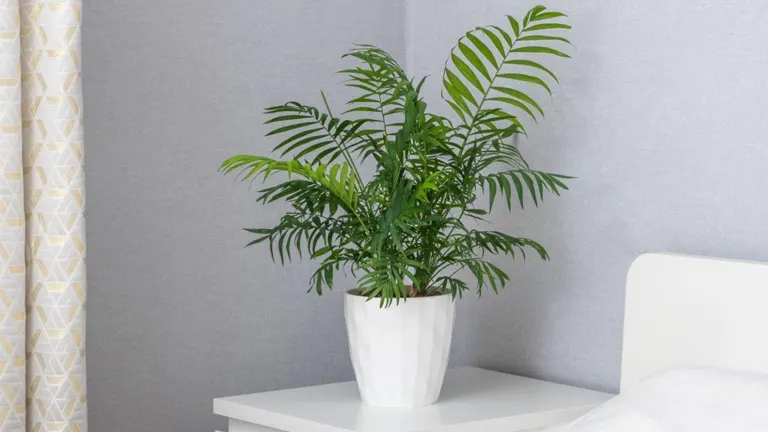
For those who prefer a more subdued and elegant green touch, the Parlor Palm is a perfect choice. It’s a slow-growing palm that thrives even in low-light conditions, making it ideal for apartments and offices. Its delicate fronds add a soft, tropical ambiance to any space, and its ease of care makes it a favorite among indoor gardeners.
- Decorating Tips: Ideal for creating a relaxed, tropical atmosphere in casual or coastal-themed rooms. Rattan or wicker planters enhance its beachy vibe.
- Care Tips: Thrives in medium to low light. Water when the top soil feels dry. Prefers higher humidity.
- Common Mistakes: Overwatering, leading to root rot. Excessive direct sunlight can scorch the leaves.
4. Dragon Tree (Dracaena Marginata)
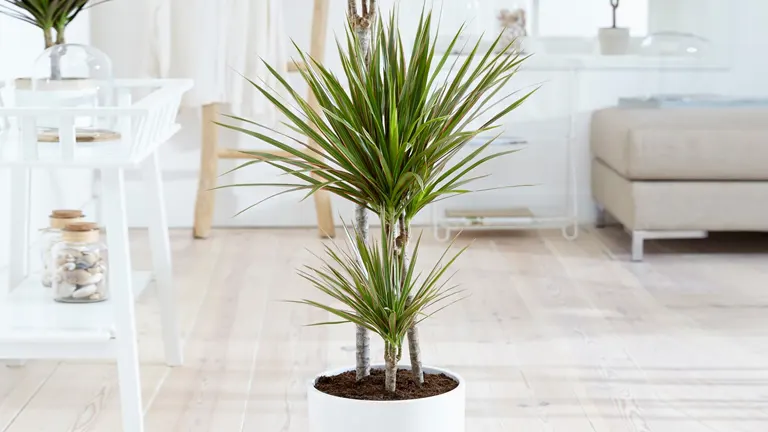
The Dragon Tree stands out with its architectural form and vibrant, sword-like leaves. It’s particularly suited for modern and minimalist spaces. This hardy tree is drought-resistant and can adapt to various lighting conditions. Besides its aesthetic appeal, it’s renowned for its air-purifying abilities, making it a practical addition to any room.
- Decorating Tips: Perfect for minimalist and avant-garde spaces. Use tall, slender pots to accentuate its architectural form.
- Care Tips: Can tolerate a range of light conditions. Let the soil dry between waterings. Avoid fluoride in water.
- Common Mistakes: Overwatering and using fluoridated water, can cause leaf browning.
5. Weeping Fig (Ficus Benjamin)
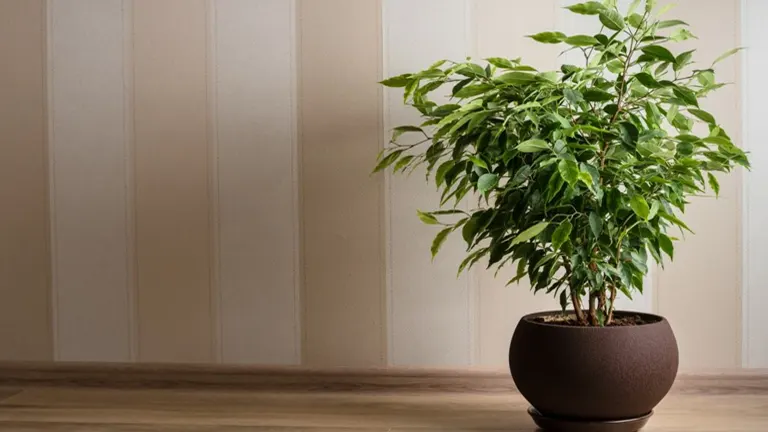
A timeless classic, the Weeping Fig is beloved for its elegant form and glossy leaves. While it prefers bright, indirect light, it’s relatively easy to care for, requiring consistent watering and occasional pruning. Its graceful branches can transform any corner of your home into a serene retreat.
- Decorating Tips: Fits well in both formal and casual settings. A decorative pot with intricate designs complements its elegant foliage.
- Care Tips: Requires bright, indirect light. Water moderately, allowing the soil to dry slightly between waterings.
- Common Mistakes: Sudden changes in temperature or location, which can cause leaf drop. Overwatering or poor drainage.
6. Norfolk Island Pine (Araucaria Heterophylla)
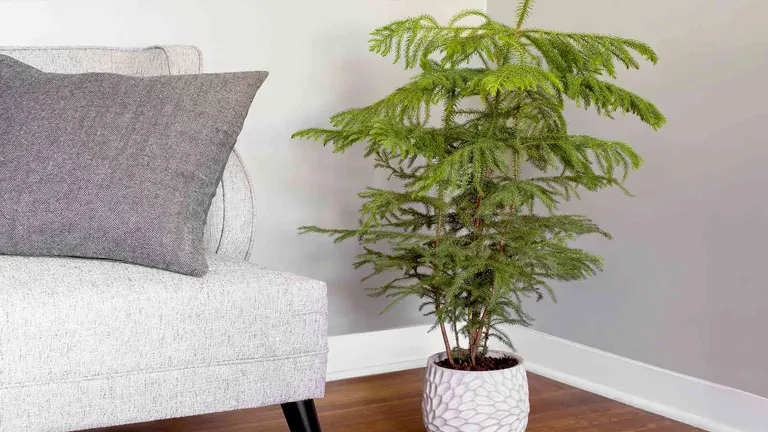
This tree brings the essence of a traditional pine indoors. It thrives in bright light and needs regular watering, making it suitable for well-lit indoor spaces. The Norfolk Island Pine can be a stunning focal point during the holidays, doubling as a living Christmas tree.
- Decorating Tips: Great for rustic or country-style homes, especially around the holidays. Wooden or stone planters match its natural pine appearance.
- Care Tips: Needs bright light and regular watering, keeping the soil consistently moist.
- Common Mistakes: Not providing enough light and over-drying the soil, leading to needle drop.
7. Yucca (Yucca Elephantipes)
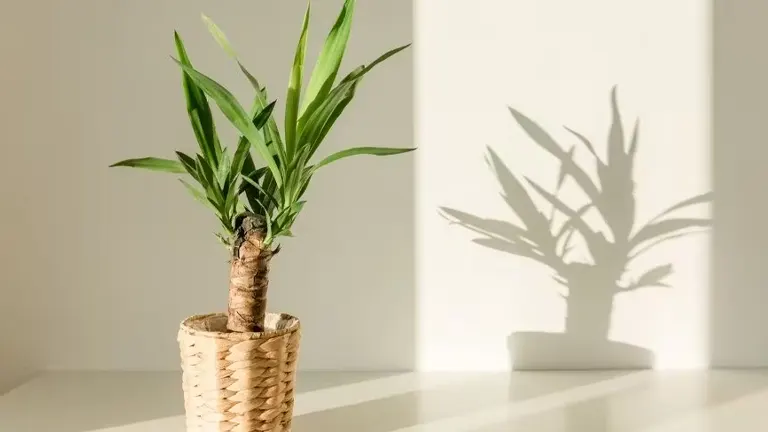
The Yucca tree is a statement piece with its bold, architectural form and stiff, pointed leaves. Highly adaptable to various indoor conditions, it requires minimal care, making it ideal for those new to indoor gardening. Its striking presence can enhance any room, from contemporary to bohemian styles.
- Decorating Tips: Suits Southwestern or desert-themed decors. Terracotta or concrete planters emphasize its rugged, desert-like qualities.
- Care Tips: Prefers full sun and well-draining soil. Water deeply but infrequently.
- Common Mistakes: Overwatering is the biggest issue, leading to root rot. Too little light can stunt growth.
8. Money Tree (Pachira Aquatic)

Last but not least, the Money Tree is renowned for its unique braided trunk and vibrant green foliage. Believed to bring good luck and fortune, it’s a popular choice for both homes and offices. It thrives in medium to bright light and needs moderate watering, making it a versatile and easy-to-care-for indoor tree.
- Decorating Tips: Versatile for various styles, especially Asian-inspired or contemporary interiors. A pot with clean lines and minimal design highlights its braided trunk.
- Care Tips: Grow in medium to bright indirect light. Water every 1-2 weeks, allowing soil to dry out between waterings.
- Common Mistakes: Overwatering, which can cause root rot. Underwatering can lead to leaf dropping.
Seasonal Care Tips: Ensuring Year-Round Health of Your Indoor Trees
Caring for indoor trees requires an understanding of their seasonal needs to ensure their year-round health and vitality. During the spring and summer months, which mark the growing season, these trees should be provided with ample light and regular watering. This is also the ideal time to give them a nutrient boost with appropriate fertilizers. As we transition into the fall and winter, the growth of indoor trees tends to slow down. During this period, it’s important to reduce the frequency of watering, adapting to their decreased water requirements. Additionally, as indoor heating systems can significantly dry out the air, providing extra humidity can be beneficial for these trees. It’s also crucial to keep them away from cold drafts, which can be detrimental to their health during the cooler months. By adjusting care routines according to the seasons, you can ensure that your indoor trees remain robust and flourishing all year round.
Conclusion
Incorporating indoor trees into your living space is not just about aesthetics; it’s about creating a healthier and more inviting environment. Each of these trees brings its own unique beauty and benefits, ensuring there’s a perfect tree for every indoor setting. Whether you’re an experienced gardener or new to plant care, these trees offer a green solution to enhance your indoor living space.
FAQs
- Can indoor trees really improve air quality in my home?
Yes, many indoor trees are known for their air-purifying qualities. They absorb pollutants and emit oxygen, improving indoor air quality. For example, the Rubber Plant and Weeping Fig are particularly effective at this. - How often should I repot my indoor tree, and what are the signs it’s time to do so?
Indoor trees typically need repotting every 2-3 years, but signs like roots growing through the drainage holes, slowed growth, or water sitting on the soil’s surface indicate it’s time for a bigger pot. - Are there any indoor trees that are safe for pets?
Absolutely! The Parlor Palm and Money Tree are examples of pet-friendly indoor trees. Always check the specific species, as some, like the Rubber Plant, can be toxic to pets. - How can I tell if my indoor tree is getting too much or too little light?
If your tree is getting too little light, it may exhibit leggy growth, leaning towards the light source, or yellowing leaves. Too much light can cause scorched or faded leaves. - What’s the best way to prune an indoor tree?
Use clean, sharp shears and prune in the dormant season. Remove any dead, damaged, or overgrown branches, and trim for shape. Avoid over-pruning, as it can stress the tree. - Can I use regular garden soil for my indoor trees?
It’s best to use a potting mix designed for indoor plants, as garden soil can be too dense, leading to poor drainage and aeration issues in pots. - How do I deal with pests on my indoor trees?
Common pests include spider mites, aphids, and mealybugs. Isolate the affected plant, and use a gentle insecticidal soap or neem oil. Regularly inspecting and cleaning your plants can prevent infestations. - What should I do if the leaves of my indoor tree start turning brown?
Brown leaves can be a sign of underwatering, overwatering, or low humidity. Check the soil moisture, adjust your watering schedule, and consider using a humidifier. - Is it possible to grow fruit-bearing trees indoors?
Yes, with the right conditions. Dwarf varieties of citrus trees, like lemons and limes, can fruit indoors if they receive enough sunlight. - Can indoor trees help reduce stress and improve mental health?
Studies have shown that indoor plants, including trees, can reduce stress and boost mood, making them a great addition to homes and workplaces for mental well-being.

David Murray
Forestry AuthorI'm David Murry, a forestry equipment specialist with a focus on chainsaw operation. With over 13 years of experience, I've honed my skills in operating and maintaining a wide range of machinery, from chainsaws to log splitters. My passion for the outdoors and commitment to sustainable forestry drive my work, which emphasizes safety, efficiency, and staying updated with industry advancements. Additionally, I'm dedicated to sharing my expertise and promoting environmental awareness within the forestry community.













Leave your comment